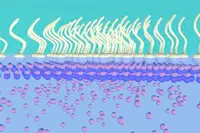 A group of materials scientists from the University of Wisconsin-Madison, led by Xudong Wang, a UW-Madison professor of materials science and engineering, and postdoctoral researcher Fei Wang, has developed a technique for creating two-dimensional sheets of compounds that do not naturally form such thin materials. It is said to be the first time such a technique has been successful.
A group of materials scientists from the University of Wisconsin-Madison, led by Xudong Wang, a UW-Madison professor of materials science and engineering, and postdoctoral researcher Fei Wang, has developed a technique for creating two-dimensional sheets of compounds that do not naturally form such thin materials. It is said to be the first time such a technique has been successful.
The scientists believe the tiny sheets of the semiconductor zinc oxide they're growing could have huge implications for the future of a host of electronic and biomedical devices.
Prof Wang said: "What's nice with a 2-D nanomaterial is that because it's a sheet, it's much easier for us to manipulate compared to other types of nanomaterials.”
Until now, materials scientists were limited to working with naturally occurring 2-D nanosheets. These natural 2-D structures include graphene and a limited number of other compounds.
Developing a reliable method to synthesise and manufacture 2-D nanosheets from other materials has been a goal of materials researchers and the nanotechnology industry for years.
In their technique, the UW-Madison team applied a specially formulated surfactant - a detergent-like substance - onto the surface of a liquid containing zinc ions.
Due to its chemical properties, the surfactant assembles itself into a single layer at the surface of the liquid, with negatively charged sulphate ions pointed in the direction of the liquid. Those sulphate ions draw the positively charged zinc ions from within the liquid to the surface, and within hours enough zinc ions are drawn up to form continuous zinc oxide nanosheets a few atomic layers thick.
Prof Wang first had the idea for using a surfactant to grow nanosheets during a lecture he was giving in a course on nanotechnology in 2009.
"The course includes a lecture about self-assembly of monolayers," he explained. "Under the correct conditions, a surfactant will self-assemble to form a monolayer. This is a well-known process that I teach in class. So while teaching this, I wondered why we wouldn't be able to reverse this method and use the surfactant monolayer first to grow the crystalline face."
After five years of trial and error with different surfactant solutions, the idea paid off.
The researchers have found that the 2-D zinc oxide nanosheets they've grown are able to function as semiconductor transistors called a p-type, the opposite electronic behaviour of naturally occurring zinc oxide. These nanosheets have potential for use in sensors, transducers and optical devices.
The UW-Madison team is applying its surfactant method to growing 2-D nanosheets of gold and palladium, and they say the technique holds promise for growing nanosheets from all sorts of metals that wouldn't form them naturally.
Author
Tom Austin-Morgan
Source: www.newelectronics.co.uk

